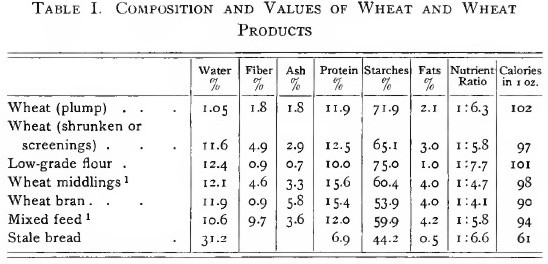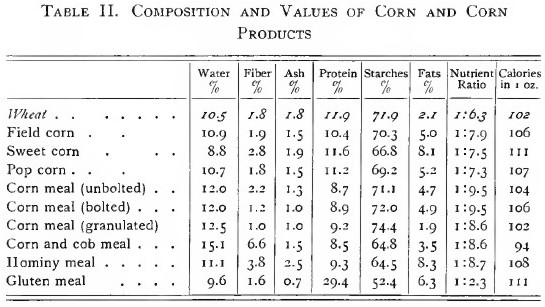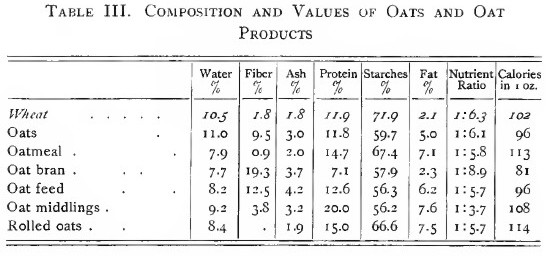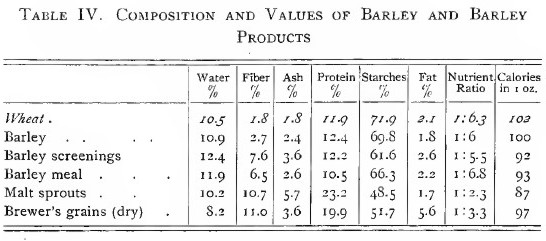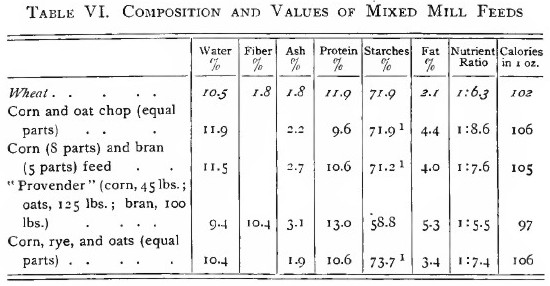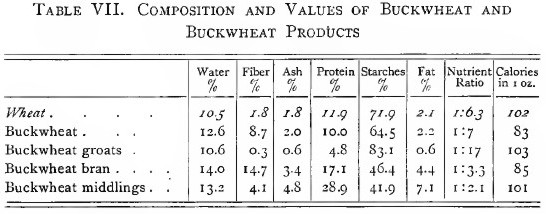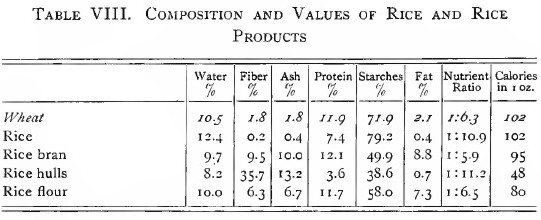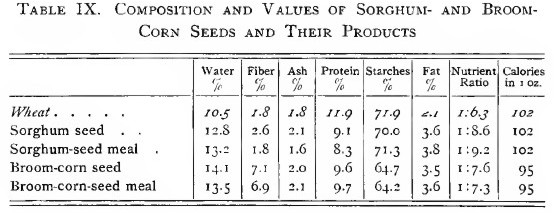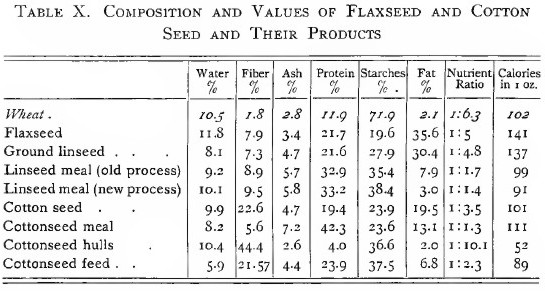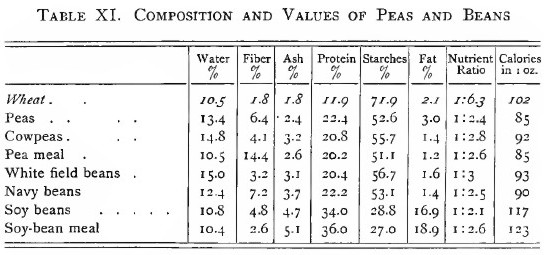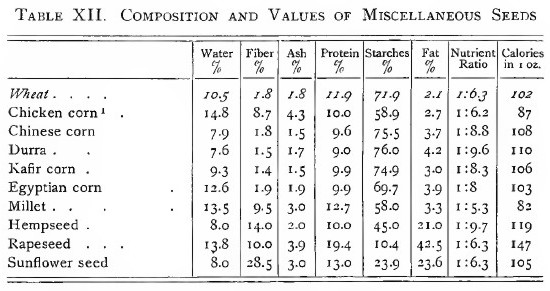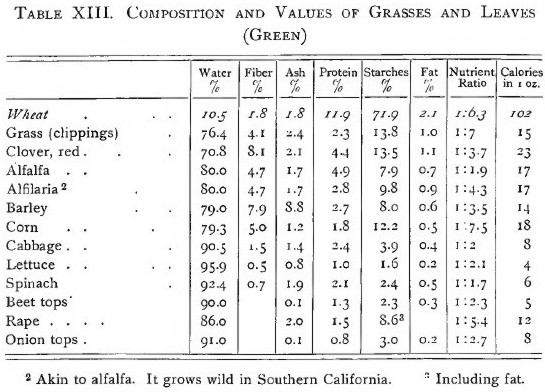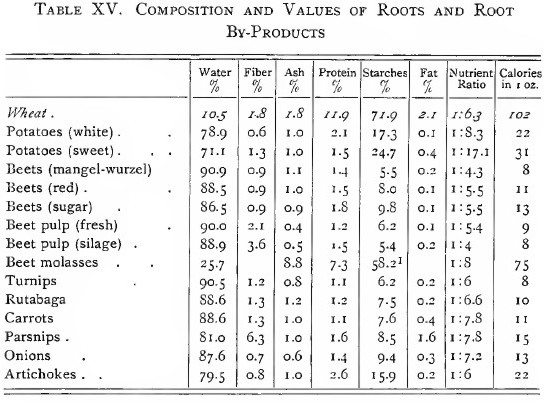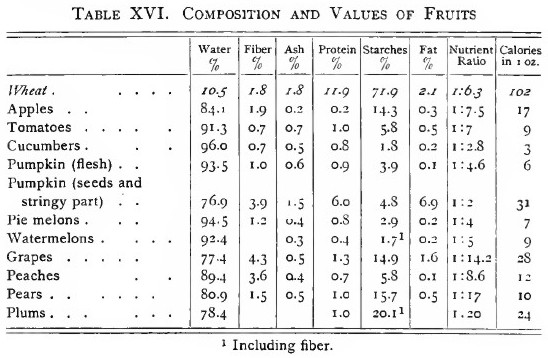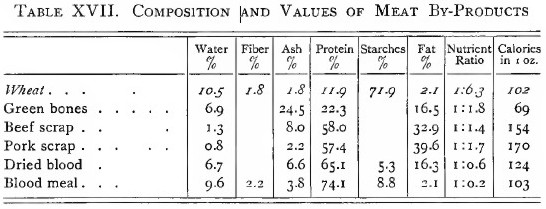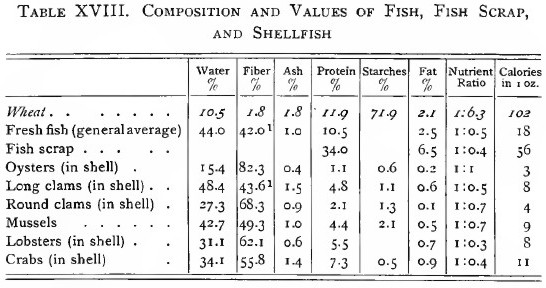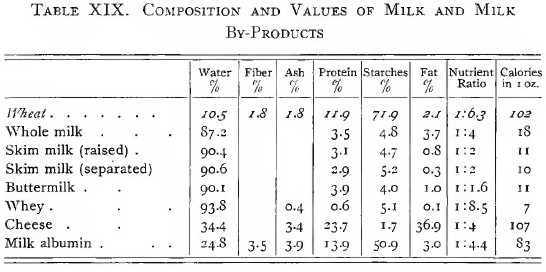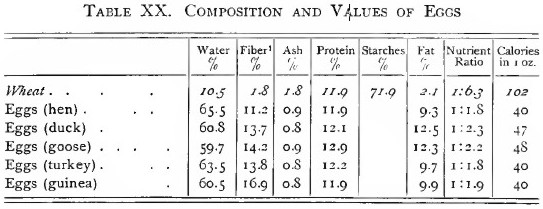Principles
and practice of poultry culture – 1912
John Henry Robinson (1863-1935)
Principi
e pratica di pollicoltura – 1912
di John Henry Robinson (1863-1935)
Trascrizione e traduzione di Elio Corti![]()
2016
Traduzione assai difficile - spesso incomprensibile
{} cancellazione – <>
aggiunta oppure correzione
CAPITOLO XII
|
[183] CHAPTER XII |
CAPITOLO XII |
||||
|
POULTRY FOODS |
CIBI PER IL POLLAME |
||||
|
The preceding chapter included a brief explanation of the general properties of foods and their relations to the nutrition of poultry. It was shown that the food value of an article was not determined solely by the quantities and proportions of principal nutrients that it contained, but was affected by physical properties and minor nutrients. In this chapter articles used for poultry food will be described as to chemical contents, physical properties, and feeding values as observed in practice. Wheat, the single food article which is the nearest to a complete food for poultry, is taken as a standard of comparison. The statement of the chemical composition and values of wheat is repeated for direct comparison with similar data for each group of foods described, and differences and resemblances which affect feeding practice are mentioned. Only whole articles and ordinary by-products are described. For descriptions of special brands and mixtures, and of proprietary articles, the reader is referred to the manufacturers and to the bulletins of his state experiment station. In making so full a list of articles which may be used as food for poultry, it was not possible to secure all statements of chemical analysis from the same source, and the figures given will not always correspond with others to which the reader may have access. Such differences are immaterial and may be disregarded. In the study of food values mathematically expressed the student should always bear in mind that the figures represent averages of samples of several or many grades. |
Il capitolo precedente includeva una breve spiegazione delle proprietà generali dei cibi e le loro relazioni con la nutrizione del pollame. Si dimostrò che il valore di cibo di un prodotto non era determinato solo dalle quantità e proporzioni dei nutrienti principali che contiene, ma era legato alle proprietà fisiche e ai nutrienti minori. In questo capitolo i prodotti usati come cibo del pollame saranno descritti come contenuti chimici, proprietà fisiche e valori alimentari come osservato nella pratica. Il grano, il solo prodotto di cibo che è il più vicino a un cibo completo per il pollame, è preso come un standard di paragone. L'affermazione della composizione chimica e dei valori del grano è ripetuta per diretto paragone con dati simili per ciascun gruppo di cibi descritti, e le differenze e somiglianze che riguardano la pratica del nutrire sono menzionate. Sono descritti solo prodotti interi e sottoprodotti ordinari. Per descrizioni di speciali tipi e miscele, e di prodotti di proprietà riservata, il lettore fa riferimento ai fabbricanti e ai bollettini della sua stazione sperimentale statale. Nel fare un così pieno elenco di prodotti che possono essere usati come cibo per il pollame, non era possibile assicurare tutte le asserzioni dalla stessa fonte dell'analisi chimica, e le figure date non corrisponderanno sempre con altre alle quali il lettore può avere accesso. Tali differenze sono irrilevanti e possono essere trascurate. Nello studio dei valori di cibo matematicamente espressi lo studente dovrebbe tenere sempre presente che le figure rappresentano medie di esempi di parecchi o molti gradi. |
||||
|
Wheat. Wheat contains the principal nutrients in about the proportions that analyses of ordinary good complete rations of mixed grains show. Physically, as compared with other grains commonly used for poultry, a grain of wheat is medium to small in size, and is smooth, having no hull. Varieties and grades of wheat vary in [184] color, plumpness, and hardness. The harder and darker-colored wheats are richest in protein and most valuable as poultry foods. Whole wheat may be fed exclusively to poultry, without apparent detriment, for a longer period than any other grain. It is preferred by most kinds of poultry to all other grains except corn. |
Grano . Il grano contiene i principali nutrienti in pressapoco le proporzioni che mostrano le analisi di buone complete razioni di granaglie mescolate. Fisicamente, se paragonato con altre granaglie comunemente usate per il pollame, un chicco di grano è la metà di una piccola dimensione, ed è liscio, non avendo guscio. Varietà e gradi del grano variano in colore, rotondità e durezza. I grani più duri e di colore più scuro sono più ricchi in proteina e più preziosi come cibo per il pollame. Il grano intero può essere dato esclusivamente al pollame, senza apparente danno, per un periodo più lungo rispetto ad ogni altra granaglia. Da molti tipi di pollame è preferito a tutte le altre granaglie eccetto il mais. |
||||
|
|
|||||
|
* The term "shorts" in some sections means middlings and in others a mixture of bran and middlings. It is sometimes applied indiscriminately to any and all kinds of wheat offals. |
* Il termine "essere a corto di soldi" in alcune sezioni significa merce di seconda qualità e in altre una miscela di crusca e merce di seconda qualità. Qualche volta è applicato indiscriminatamente a ognuno e a tutti i tipi di scarti di grano. |
||||
|
Wheat screenings. When free from foreign matter, wheat screenings and shrunken wheat are practically the same, and do not differ noticeably from plump wheat in feeding value. Screenings are often heavily adulterated with weed seeds, grain hulls, etc., and are very generally sold at too high a price, because many purchasers will take the lowest-priced article of its kind without considering quality. It is quite usual to find wheat screenings selling readily at only 10 or 12 per cent below the price of good wheat, when the value (because of adulterants) may be 15 to 20 per cent, or even more, less than that of the good wheat. |
Scarti di vagliatura del grano . Quando liberi da materiale estraneo, gli scarti di vagliatura del grano e il grano avvizzito sono praticamente gli stessi, e non differiscono in modo evidente dal grano grassoccio come valore alimentare. Gli scarti di vagliatura sono spesso pesantemente adulterati con semi di erbaccia, bucce di granaglia, ecc., e sono venduti assai generalmente a un prezzo troppo alto, perché molti acquirenti prenderanno l'articolo del suo tipo di prezzo più basso senza considerare la qualità. È piuttosto abituale trovare scarti di vagliatura che si vendono prontamente solo al 10 o 12 % al disotto del prezzo del buon grano, quando il valore (a causa di adulteranti) può essere dal 15 al 20 %, o anche più, inferiore a quello del grano buono. |
||||
|
Low-grade flour. Wheat flour not suitable for bread making is a most valuable ingredient in mashes, both adding to the nutrients and improving the consistency of mashes made from coarse by-products. Low-grade flour is also called red-dog flour. |
Farina di bassa qualità . Farina di grano non adeguata per fare del pane è un ingrediente più prezioso in miscele, sia aggiungendola ai nutrienti che migliorando la consistenza di mescolanze fatte con sottoprodotti scadenti. La farina di bassa qualità è anche chiamata farina rosso cane. |
||||
|
Middlings. Coarse flour and fine bran, in varying proportions in different lots and in the products of different mills, is called middlings. In many sections middlings, as a separate article, is rarely found on the market. |
Farina grossa mescolata a crusca . Farina scadente e crusca eccellente, in proporzioni diverse in gran quantità e nei prodotti di mulini diversi, è chiamata farina grossa mescolata a crusca. In molte sezioni la farina grossa mescolata a crusca, come articolo separato, è raramente trovata sul mercato. |
||||
|
[185] Bran. Bran is the coarser part of ground wheat. Pure bran is much lower in feeding value than is indicated by its analysis. Much of the product now sold as bran contains a large proportion of middlings and is also sold under the names "mixed feed" and "shorts." |
Crusca . La crusca è la parte più comune del grano macinato. La crusca pura è molto più bassa come valore alimentare di quanto è indicato dalla sua analisi. Molto del prodotto ora venduto come crusca contiene in grande proporzione della farina grossa mescolata a crusca ed è venduto anche sotto i nomi "mangime misto" e "essere a corto di soldi". |
||||
|
Stale bread. The greater part of the stale bread used for poultry food is white bread, but often the refuse bread from city bakeries, hotels, and restaurants contains considerable proportions of other kinds of bread and of cake. All such articles are valuable foods for poultry and, at the usual prices, are cheap foods. |
Vecchio pane . La maggior parte del vecchio pane usato come cibo per il pollame è pane bianco, ma spesso il pane di scarto di panetterie urbane, alberghi e ristoranti contiene proporzioni considerevoli di altri tipi di pane e focaccia. Tutti tali prodotti sono cibi preziosi per il pollame e, ai soliti prezzi, sono cibi convenienti. |
||||
|
Note. A comparison of the nutrient ratios and fuel values of these wheat products with those of whole wheat indicates for them a feeding value closely approximating that of wheat, but stale bread is the only one of them that in practice gives the results that the comparison suggests. Though usually fed only as a part of the ration (in a mash), it has been used for long periods, with excellent results, as the only grain food for fowls and chicks on range. The nutrient ratio is nearly the same as that of wheat. The low fuel value indicated is due to the high per cent of water. Low-grade flour, differing little from wheat in the proportions and values of principal nutrients, can, because of its form, be fed only in combination with coarser and less glutinous materials. Middlings and bran both compare very closely with wheat, and good rations for continuous use may be compounded, having the nutrient proportions and fuel values of these by-products; yet neither of them alone, nor the two in combination, will go very far in feeding. The percentage of fiber is high in both, and especially high in bran. Their chief service in poultry feeding is to dilute and temper the corn meal, which is the basis of most mashes and which supplies in cheaper form some of the nutrients in the wheat flour of which these are by-products. |
Nota. Un paragone dei rapporti nutrienti e valori di combustibile di questi prodotti di grano con quelli di grano intero indicano per loro un valore nutriente che si avvicina assai a quello del grano, ma il vecchio pane è l’unico di loro che in pratica dà i risultati che il paragone suggerisce. Sebbene di solito mangiato solo come una parte della razione (in un miscuglio), è stato usato per lunghi periodi, con risultati eccellenti, come l'unico cibo di grano per polli e pulcini in serie. Il valore nutriente è quasi lo stesso come quello del grano. Il basso valore di combustibile indicato è dovuto all'alta percentuale di acqua. Farina di basso grado, differendo poco dal grano nelle proporzioni e nei valori di nutrienti principali, può, a causa della sua forma, essere dato come alimento solo in combinazione con materiali più comuni e meno glutinosi. Merce di seconda qualità e crusca sono ambedue paragonabili molto da vicino con il grano, e buone razioni per un uso continuo possono essere combinate, avendo le proporzioni nutrienti e i valori di combustibile di questi sottoprodotti; ancora nessuno di loro da solo, né i due in combinazione andranno molto lontano nell'alimentare. La percentuale di fibra è alta in ambedue, e specialmente alta nella crusca. Il loro servizio principale nell’alimentare il pollame è diluire e stemperare la farina di mais che è la base di molte mescolanze e che fornisce in una forma più economica qualcuno dei nutrienti nella farina di grano di cui questi sono i sottoprodotti. |
||||
|
Corn. In nearly all parts of the United States field corn is the principal grain used for poultry food. In percentages of nutrients it does not differ greatly from wheat, except in fats. The grains of corn are from four to six times as large as grains of wheat. As a rule, when poultry have access to a variety of whole grains, they eat the corn first. When cracked corn is mixed with other grains, this preference is less marked, which suggests that the larger size of the grain may be the attraction. Yellow and white corn show in analysis no difference in principal nutrients. In feeding practice no difference is noted, except that yellow corn gives its color to the fat of birds fed on it and to the yolks of their eggs. Many [186] poultry keepers consider hard (flint) corn a better food than soft (dent) corn, but in common practice no difference is observed. Sweet corn and pop corn are practically the same in feeding value as field corn but are not generally available for poultry feeding. Because whole corn may be eaten so rapidly that a full meal is quickly secured without exercise, the practice of feeding cracked corn has become general. Cracked corn, when fresh, does not differ in composition from the whole corn of which it was made, but after being cracked it may deteriorate rapidly, especially in warm weather. It is peculiarly subject to heating and to molds, and when stale or moldy is a most unsafe food, particularly for young stock. It is usually cracked in two sizes, ― coarse, for general use, and fine, for small chicks. Corn is the most easily digested of the common grains. Because of this and its heating properties, the free use of corn for fowls in close confinement and not plentifully supplied with green food is usually followed, in hot weather, by digestive disorders. With due attention to exercise, and with abundant supplies of green food and the less concentrated animal foods (insects, milk), good results may be obtained from a diet in which corn is the only grain fed. In extreme cold weather it may be fed more freely. |
Mais . In quasi tutte le parti degli Stati Uniti il granturco di campo è la principale granaglia usata come cibo per il pollame. Per le percentuali di nutrienti non differisce molto dal grano, eccetto che in grassi. I chicchi di mais sono da 4 a 6 volte più grandi dei chicchi di grano. Come regola, quando il pollame ha accesso a una varietà di chicchi interi, mangia come prima cosa il mais. Quando del mais spezzato è mescolato con altre granaglie, questa preferenza è meno marcata, il che suggerisce che la maggiore dimensione del chicco può essere l'attrazione. Il mais giallo e bianco se analizzati non mostrano alcuna differenza in nutrienti principali. Nella pratica alimentare nessuna differenza è notata, eccetto che il mais giallo dà il suo colore al grasso di uccelli alimentati con esso e ai tuorli delle loro uova. Molti allevatori di pollame considerano il mais duro (selce) un cibo migliore di quello molle (dentello), ma nella pratica comune nessuna differenza è osservata. Mais dolce e mais scoppiato come valore alimentare sono praticamente gli stessi come il mais di campo ma non sono generalmente disponibili per alimentare il pollame. Poiché il mais intero può essere mangiato così rapidamente che un pieno pasto è rapidamente assicurato senza sforzo, la pratica di alimentare con mais spezzato è diventata generale. Il mais spezzato, quando fresco, non differisce in composizione dal mais intero con cui fu fatto, ma dopo essere stato spezzato può deteriorarsi rapidamente, specialmente quando fa caldo. È particolarmente soggetto a riscaldarsi e ad ammuffire, e quando stantio o ammuffito è un cibo più pericoloso, particolarmente per un giovane gruppo. È rotto di solito in due dimensioni ― grossolano, per uso generale, e sottile, per piccoli pulcini. Il mais è la granaglia comune più facilmente digerita. A causa di ciò e delle sue proprietà riscaldanti, il libero uso di mais per polli in stretta segregazione e non abbondantemente approvvigionati di cibo verde è di solito seguito, quando fa caldo, da disturbi digestivi. Con la dovuta attenzione all’esercizio, e con approvvigionamenti abbondanti di cibo verde e di cibi animali meno concentrati (insetti, latte), buoni risultati possono essere ottenuti da una dieta in cui il mais è l'unica granaglia data come cibo. Quando fa estremamente freddo può essere dato come cibo più liberamente. |
||||
|
|
|||||
|
Corn meal. Corn meal is the foundation of most mashes for poultry. Coarse, unbolted meal is to be preferred, and if mashes are cooked or given time to swell after mixing, the coarser corn chop [187] will be still better. The corn meals on the market vary greatly in quality; a great deal of what is offered for stock feeding is made of inferior or damaged corn. Corn meal is very liable to heat in warm weather. The heating may be stopped by spreading the meal two or three inches thick in a bin or on a clean floor, but if the meal when cold smells musty or sour, it should not be fed to poultry. |
Farina di mais . La farina di mais è la base del maggior numero di pastoni per il pollame. Grezza, la farina non setacciata sarà preferita, e se i pastoni sono cucinati o viene dato loro il tempo per gonfiare dopo aver mescolato, il più grezzo pezzo di mais sarà ancora il migliore. Le farine di mais sul mercato variano assai in qualità; una grande quantità di ciò che è offerto per cibo di gruppo è fatto con mais inferiore o danneggiato. La farina di mais è molto responsabile dello scaldare quando fa caldo. Il riscaldamento può essere bloccato spargendo la farina con uno spessore di 2 o 3 pollici in un contenitore o su un pavimento pulito, ma se la farina quando fredda odora di ammuffito o si inacidisce, non dovrebbe essere data al pollame. |
||||
|
Corn bran and corn middlings. Corn bran has considerably less food value than corn meal. Corn middlings is richer than meal in both protein and fat, and probably has a slightly greater feeding value. |
Crusca di mais e mais di seconda qualità . La crusca di mais come cibo ha assai meno valore della farina di mais. Il mais di seconda qualità è più ricco della farina sia in proteina che in grasso, e probabilmente come cibo ha un valore leggermente maggiore. |
||||
|
Corn and cob meal. Unless a large part of the coarse, fibrous material of the cob is sifted out, corn and cob meal does not make a satisfactory poultry food. As a rule, poultrymen prefer to dilute corn-meal mixtures with wheat bran or finely cut hay. |
Mais e farina di pannocchia . A meno che una gran parte del grezzo e fibroso materiale della pannocchia sia setacciato fuori, il mais e la farina di pannocchia non sono un cibo soddisfacente per il pollame. Come regola, gli avicoltori preferiscono diluire misture di farina di mais con crusca di grano o fieno finemente tagliato. |
||||
|
Hominy meal. The soft part of the corn kernel remaining after the hard part has been separated in the manufacture of hominy grits is ground into hominy meal. It has about the same analysis as corn meal, and in localities where it can be obtained is often substituted for it, as the more economical of the two foods. |
Farina di granoturco spezzettato (o macinato) . La parte molle del nocciolo di mais che rimane dopo che la parte dura è stata separata nel prodotto di tritume di granoturco spezzettato, viene macinata in farina di granoturco spezzettato. Ha circa la stessa analisi come la farina di mais, e in località dove può essere ottenuta è spesso sostituita al suo posto, come il più economico dei due cibi. |
||||
|
Gluten meal and gluten feed. Gluten meal is one of the products separated from corn in the manufacture of glucose; gluten feed is a mixture of this with other by-products of the same process. Both are very rich in protein and fat. They are not extensively used for poultry, chiefly, perhaps, because meat meals and scraps have been found so satisfactory in supplementing the supplies of those elements in the ordinary poultry foods. |
Farina di glutine e cibo di glutine . La farina di glutine è uno dei prodotti separati dal mais nella produzione del glucosio; cibo di glutine è una miscela di questa con altri sottoprodotti dello stesso processo. Ambedue sono molto ricchi in proteina e grasso. Non sono usati estesamente per il pollame, forse principalmente perché pasti e avanzi di carne sono stati trovati così soddisfacenti nel completare gli approvvigionamenti di questi elementi nei comuni cibi del pollame. |
||||
|
Whole oats. When of good quality, whole oats are about equal to wheat in feeding value. The fibrous hull makes them less acceptable to poultry than a smooth grain, and when a choice is offered, they neglect the oats. When kept on an oat diet, however, they eat oats freely, provided they are of good quality. In oat-growing sections, oats are often the only grain fed. Clipped and hulled oats are sometimes used, but do not appear to be more attractive to poultry than whole oats of good quality. Birds familiar with other grains show a lack of eagerness for hulled oats and various milled forms of oats; this indicates that the fibrous hull is not the only feature objectionable to them. It is probable that the objectionable property is the fat, which is as abundant as in corn [188] and has a less pleasing flavor. The generally poor quality of oats offered for stock food tends to diminish their use as food for poultry. |
Avena intera . Quando di buona qualità, l’avena intera è quasi uguale al grano come valore alimentare. La buccia fibrosa la fa meno accettabile al pollame rispetto a una granaglia liscia, e quando è offerta una scelta, trascura l’avena. Tuttavia, quando tenuto a una dieta d’avena, mangia liberamente l’avena, purché sia di buona qualità. Nei settori che coltivano l’avena, spesso l’avena è l'unica granaglia usata per alimento. Talora è usata un’avena tosata e sgusciata, ma non sembra essere più attraente per il pollame rispetto all’avena intera di buona qualità. Uccelli familiari con altre granaglie mostrano una mancanza di ansia per l’avena sgusciata e le varie forme macinate di avena; ciò indica che la buccia fibrosa non è l'unica caratteristica deplorevole per loro. È probabile che la deplorevole proprietà è il grasso che è tanto abbondante come nel mais e ha un sapore meno piacevole. La qualità generalmente povera dell’avena offerta come cibo di scorta tende a diminuire il suo uso come cibo per il pollame. |
||||
|
|
|||||
|
Oatmeal. Oatmeal was long considered the best of foods for chicks. This idea of its quality was based on tradition rather than on results. It was common, years ago, for poultry growers to buy the pinhead oatmeal prepared for human food, paying for it three or four times the price of corn products, which, with a little modification, could be made equal in nutrient values (if that were necessary) and which are much preferred by the poultry. Of late years the use of oat products for young chickens is less common, and rolled oats is generally used instead of oatmeal. At the usual prices they are not economical foods. |
Farina d'avena . La farina d'avena fu a lungo considerata il meglio come cibo per i pulcini. Questa idea della sua qualità era basata sulla tradizione piuttosto che sui risultati. Anni fa per gli allevatori di pollame era comune comprare la farina d'avena a capocchia di spillo preparata per cibo umano, pagando per essa 3 o 4 volte il prezzo dei prodotti di mais che, con una piccola modifica, potrebbero essere uguali come valori nutritivi (se fosse necessario) e che sono molto preferiti dal pollame. Negli ultimi anni l'uso di prodotti d’avena per giovani polli è meno comune, e avena spulata e frantumata è generalmente usata invece della farina d'avena. Ai prezzi abituali non sono cibi economici. |
||||
|
Oat bran and oat feed. As Table III shows, oat bran and oat feed contain very large percentages of fiber. They are rarely offered for sale as straight products, but appear in combination with ingredients which supplement their deficiencies. |
Crusca d’avena e mangime d’avena . Come mostra la III tabella, la crusca d’avena e il mangime d’avena contengono percentuali molto grandi di fibra. Sono raramente offerti in vendita come prodotti perbene, ma appaiono in combinazione con ingredienti che fanno aggiunte alle loro deficienze. |
||||
|
Oat middlings. Oat middlings is a high-quality product, but is not extensively manufactured and is not much used for poultry. |
Avena di seconda qualità . L’avena di seconda qualità è un prodotto di alta qualità, ma non è largamente fabbricato e non è molto usato per il pollame. |
||||
|
Sprouted oats. Oats sprouted until the blades are from four to six inches long are much relished by poultry, but it is usually more economical to provide a green food which does not require so much care in preparation. |
Avena germogliata . L’avena germogliata fino a quando le lamine sono lunghe da 4 a 6 pollici è molto apprezzata dal pollame, ma è di solito più economico provvedere un cibo verde che non richiede così tanta cura nella preparazione. |
||||
|
Barley. By analysis barley appears almost identical with wheat in feeding value. Its nutritive ratio is slightly narrower and by so much nearer to that of average good rations. As usually sold, with the hull on, it is eaten by poultry less readily than wheat, [189] but in barley of good grade the proportion of fiber is small compared with the fiber content of good oats, and fowls habituated to the use of whole barley, and not also supplied with wheat, will eat it quite as freely as they would wheat. In practical feeding, wheat and barley show no difference in results. There is an increasing use of whole barley as poultry food in barley-growing sections. Its use in other sections is less general, because of irregularity of supply. It is usually sold at a figure enough lower than the price of wheat of corresponding quality to make it the more economical food. |
Orzo . Da un’analisi l’orzo appare quasi identico al grano come valore alimentare. Il suo rapporto nutritivo è leggermente inferiore e molto più vicino a quello di buone razioni comuni. Come è venduto di solito, con la buccia, dal pollame è mangiato meno prontamente del grano, ma in orzo di buona qualità la proporzione di fibra è piccola se paragonata col contenuto di fibra di buone avene, e i polli si sono abituati all'uso di orzo intero, e anche se non provvisto di grano, lo mangerà del tutto liberamente come farebbero con il grano. In un’alimentazione pratica, il grano e l’orzo non mostrano alcuna differenza nei risultati. C'è un impiego in aumento di orzo intero come cibo del pollame in sezioni che crescono con l’orzo. Il suo uso nelle altre sezioni è meno generale, a causa dell'irregolarità di rifornimento. È abitualmente venduto a un prezzo abbastanza più basso del prezzo del grano di qualità corrispondente per renderlo un cibo più economico. |
||||
|
|
|||||
|
Barley screenings. Barley screenings consist of the less-developed grains and often contain broken hulls, particles of straw, etc. If clean they may be equal to good barley in feeding value. |
Vagli dell’orzo . I vagli dell’orzo consistono nei chicchi meno sviluppati e spesso contengono bucce rotte, particelle di paglia ecc. Se puliti possono essere uguali al buon orzo come valore alimentare. |
||||
|
Barley meal. Barley meal is almost unknown to American poultry keepers, very little of this grain being milled. |
Farina d’orzo . La farina d’orzo è quasi ignota agli allevatori americani di pollame, essendo macinata molto poca di questa granaglia. |
||||
|
Malt sprouts. The sprouts removed from barley sprouted in the manufacture of beer are used principally for cattle feed but occasionally for poultry. |
Germogli di malto . I germogli rimossi dall’orzo germogliato nella fabbricazione della birra sono usati principalmente come alimento per i bovini ma di quando in quando per il pollame. |
||||
|
Dried brewer’s grains. The residue from barley in the manufacture of beer consists of a small part of the starch with most of the gluten, the germ, and the hull and is called brewer’s grain. Its use as poultry food has not been extensive enough to determine its value. At an appropriate price it should be a valuable food. |
I chicchi essiccati del fabbricante di birra . Il residuo di orzo nella produzione della birra consiste in piccola parte di amido con la maggior parte di glutine, germe e buccia, ed è chiamato chicco del fabbricante di birra. Il suo uso come cibo del pollame non è stato abbastanza esteso da determinare il suo valore. A un prezzo appropriato dovrebbe essere un cibo di grande valore. |
||||
|
Rye. From the poultry feeder’s standpoint rye is an anomaly among grains. As analyzed it closely resembles wheat and is not markedly unlike it in appearance; the grains are smooth and a little smaller in size. When fed to poultry accustomed to other grains, rye is eaten by them reluctantly and in small quantities. [190] On the other hand, the fact that poultry having access to ground recently seeded with rye, though liberally fed on other grains, eat it as readily as any grain, suggests that the changes incident to germination make it more palatable to them. The extent to which rye is used as food for both human beings and live stock in some foreign countries indicates that it does not differ greatly from the other grains in actual feeding value, and that, if necessary, it might be more extensively used here. With abundance of other foods there is no occasion to force poultry to a rye diet. |
Segale . Dal di punto di vista dell'alimentatore del pollame la segale è un'anomalia fra le granaglie. Se analizzata assomiglia da vicino al grano e non ne è marcatamente diversa in aspetto; i chicchi sono lisci e di dimensione un po’ più piccola. Quando data come alimento a pollame abituato ad altri chicchi, la segale è mangiata di malavoglia e in piccole quantità. D'altra parte il fatto che il pollame che ha accesso a un terreno recentemente seminato con segale, sebbene alimentato liberalmente con altre granaglie, la mangi tanto prontamente come qualunque granaglia, suggerisce che i cambi dovuti alla germinazione la rendono per loro più appetitosa. L'estensione in cui la segale è usata come cibo sia per gli esseri umani che per gruppi di esseri viventi in alcuni paesi stranieri indica che non differisce molto dalle altre granaglie come attuale valore di cibo, e che, se necessario, vi potrebbe essere usata più estensivamente. Con abbondanza di altri cibi non è necessario costringere il pollame a una dieta di segale. |
||||
|
|
|||||
|
|
|||||
|
Mixed mill feeds. Under this head are described ground mixtures of the common grains and of their by-products. Such mixtures are usually made for a special demand, or to work off grains, like rye and low-grade oats, that are not readily salable in their natural form. They are, as a rule, more uniform in quality and [191] more satisfactory than mixtures of by-products, because all nutrients are present in natural proportions. The chief fault in mixtures containing oats is the presence of the loose, broken hulls, which, apparently, irritate the digestive organs much more than when swallowed on the whole oat. On this account these mixtures are particularly injurious to young poultry, and when fed to them should be sifted before wetting. They are also liable to heating in warm weather. |
Cibi di mulino mescolati . Sotto questa testata sono descritte misture macinate delle granaglie comuni e dei loro sottoprodotti. Tali misture sono di solito fatte per una richiesta speciale, o per eliminare granaglie, come segale e avena di basso grado che non sono prontamente smerciabili nella loro forma naturale. Sono, come regola, più uniformi in qualità e più soddisfacenti delle misture di sottoprodotti, perché sono presenti tutti i nutrienti in proporzioni naturali. La colpa principale in misture che contengono avena è la presenza delle bucce disfatte, rotte, che apparentemente irritano gli organi digestivi molto più di quando ingoiate con l'avena intera. A causa di ciò queste misture sono particolarmente dannose al pollame giovane, e quando gli vengono date come alimento dovrebbero essere setacciate prima di essere bagnate. Sono anche responsabili di scaldare quando fa caldo. |
||||
|
|
|||||
|
Buckwheat. As a food for poultry, buckwheat appears much oftener in grain mixtures than alone. Its analysis compares quite closely with that of wheat, except as to fiber and ash. It is a large seed, angular, with hard hull, and poultry are quite indifferent to it in the whole form. |
Grano saraceno . Come cibo per il pollame, il grano saraceno appare più frequentemente in misture di granaglie che da solo. La sua analisi è paragonabile assai da vicino con quella del grano, eccetto che come fibra e cenere. È un grosso seme, angolare con guscio duro, e il pollame gli è piuttosto indifferente nella forma intera. |
||||
|
Buckwheat groats, buckwheat bran, and buckwheat middlings. Buckwheat groats is hulled or crushed buckwheat. Buckwheat bran is sometimes used in place of wheat bran and is very satisfactory. Buckwheat middlings is also used occasionally in mashes. None of the buckwheat products, however, are extensively used for poultry in this country. In Europe their use is more common, as the preference there for white fat in poultry makes corn an objectionable food. |
Grano saraceno essiccato e frantumato, crusca di grano saraceno e merce di seconda qualità del grano saraceno . Il grano saraceno essiccato e frantumato è grano saraceno sgusciato o schiacciato. Crusca di grano saraceno è talora usata in luogo di crusca di grano ed è molto soddisfacente. Merce di seconda qualità del grano saraceno è anche usata di quando in quando in miscele. Tuttavia in questo paese nessuno dei prodotti di grano saraceno è usato in modo estensivo per il pollame. In Europa il loro uso è più comune, dato che là la preferenza per il grasso bianco nel pollame rende il mais un cibo detestabile. |
||||
|
Rice. Rice and rice products are little used as poultry food except in countries where rice is the staple food for human beings. In this country the quantities available at prices which warrant feeding to poultry are too limited to admit of their general use. Broken rice is often used in chick-feed mixtures. Occasionally a poultryman secures a lot of broken or slightly damaged rice, or of [192] a rice by-product, at a price proportionate to its feeding value and to the price of staple grains fed to poultry. |
Riso . Il riso e i prodotti di riso sono poco usati come cibo per il pollame eccetto in paesi dove è il riso il cibo principale per gli esseri umani. In questo paese le quantità disponibili a prezzi che garantiscono di alimentare il pollame sono molto limitate per ammetterne un uso generale. Il riso rotto è spesso usato in miscele per alimentare il pulcino. Di quando in quando un avicoltore assicura molto riso rotto o lievemente danneggiato, o un sottoprodotto di riso, a un prezzo proporzionato al suo valore alimentare e al prezzo di granaglie principali date al pollame. |
||||
|
|
|||||
|
Sorghum seed. Sorghum seed is more like corn than wheat in its constituents, but is smaller than wheat, round and smooth. It is not generally available for poultry food but, when procurable at a price not higher than that of wheat, makes a desirable food. Sorghum-seed meal may be used, in whole or in part, as a substitute for corn meal. |
Seme di sorgo . Il seme di sorgo nei suoi costituenti è più simile al mais che al grano, ma è più piccolo del grano, rotondo e liscio. Non è generalmente disponibile come cibo per il pollame ma, quando procurabile a un prezzo non più alto di quello del grano, costituisce un cibo desiderabile. La farina del seme di sorgo può essere usata, per intero o in parte, come un sostituto della farina di mais. |
||||
|
|
|||||
|
Broom-corn seed. Broom-corn seed is nearer wheat in nutrient ratio than sorghum seed and lower in fuel value. In appearance it greatly resembles sorghum seed. Poultry may not eat it freely with the hull on, but will eat the cleaned seed quite as readily as wheat, and thrive just as well on it. Broom-corn-seed meal may be used to some extent as a substitute for corn meal and middlings. |
Seme di ginestra . Il seme di ginestra come potere nutriente è più vicino al grano rispetto al seme di sorgo ed è più basso come valore combustibile. Nell’aspetto assomiglia molto al seme di sorgo. Il pollame non può mangiarlo liberamente se ha la buccia, ma mangerà alla svelta come il grano il seme completamente pulito, e prospera bene con esso. La farina di seme di ginestra può essere usata in una certa misura come sostituto di un pasto di mais e di seconda qualità. |
||||
|
Flaxseed and cotton seed. Whole flaxseed and cotton seed can hardly be considered as poultry foods, but their analyses are given [193] for purposes of comparison. If available, either could be used in small quantities, but it would not be advisable to compel poultry to eat more of seeds so rich in vegetable fats and protein than they would take freely when fed a liberal general ration. |
Seme di lino e seme di cotone . Il seme di lino intero e il seme di cotone possono essere considerati a malapena come cibi per il pollame, ma le loro analisi sono fornite a scopo di paragone. Se disponibili, entrambi potrebbero essere usati in piccole quantità, ma non sarebbe consigliabile costringere il pollame a mangiare parecchi semi così ricchi in grassi vegetali e proteina più di quanto assumerebbero liberamente quando alimentati con una libera razione generale. |
||||
|
|
|||||
|
Ground linseed. Ground flaxseed from which the oil has not been extracted is called ground linseed. |
Seme di lino macinato . Il seme di lino macinato dal quale non è stato estratto l’olio è detto seme di lino macinato. |
||||
|
Linseed meal. Linseed meal is ground flaxseed from which the oil has been extracted. Old-process meal is made from seed from which as much as possible of the oil has been extracted by pressure. New-process meal is made from the residue of seed from which a large percentage of the oil has been removed by a chemical process. Old-process linseed meal is often called simply oil meal. New-process linseed meal often goes by the trade name "Cleveland flax meal." |
Farina di seme di lino . La farina di seme di lino è un seme di lino macinato dal quale l’olio è stato estratto. La farina di vecchio processo è fatta col seme dal quale per quanto possibile l’olio è stato estratto con la pressione. La farina di nuovo processo è fatta col residuo di seme dal quale una grande percentuale d’olio è stata rimossa con un processo chimico. La farina di seme di lino di vecchio processo è spesso chiamata semplicemente farina di olio. La farina di seme di lino di nuovo processo spesso passa sotto la denominazione commerciale "farina di lino del Cleveland". |
||||
|
Cottonseed meal, cottonseed feed, and cottonseed hulls. Cottonseed meal is the only one of the three by-products of the manufacture of cottonseed oil in which a poultry feeder would usually be interested. Cottonseed feed might be used (at the right price) in a ration which did not otherwise contain much fiber and fat. The meals of this class are sometimes used in poultry feeding, but are not popular as poultry foods, because it is found generally more satisfactory to use animal foods to add to the protein and fat in grain and vegetable rations. Cottonseed hulls are of little value for poultry. |
Farina di seme di cotone, pasto di seme di cotone, e gusci di seme di cotone . La farina di seme di cotone è l’unico dei 3 sottoprodotti della produzione di olio di seme di cotone del quale un alimentatore di pollame sarebbe di solito interessato. Il pasto di seme di cotone potrebbe essere usato (a un prezzo corretto) in una razione che per il resto non contiene molta fibra e grasso. Le farine di questa classe sono talora usate nell’alimentare il pollame, ma non sono popolari come cibi del pollame in quanto è generalmente ritenuto più soddisfacente usare cibi animali da aggiungere alla proteina e al grasso in razioni di granaglia e di vegetali. I gusci del seme di cotone sono di poco valore per il pollame. |
||||
|
[194] Peas and beans. In limited quantities peas and small beans are readily eaten by poultry. They will regularly eat a little, but object to large proportions of them in their rations. Pea meal is sometimes used in mashes, but more by amateurs and experimenters trying to secure maximum results than by others. All these products are unquestionably good poultry foods when properly combined with others in rations, but supplies are irregular and prices usually too high as compared with staple grain products to warrant using them extensively. |
Piselli e fagioli . In quantità limitate i piselli e i piccoli fagioli sono prontamente mangiati dal pollame. Mangerà regolarmente un po’, ma si oppone alle loro grandi quantità nelle sue razioni. Farina di pisello è talora usata in miscele, ma più da amatori e sperimentatori che tentano di assicurare il massimo di risultati rispetto ad altre. Tutti questi prodotti sono indiscutibilmente buoni cibi per il pollame quando correttamente combinati con altri nelle razioni, ma i rifornimenti sono irregolari e i prezzi di solito troppo alti se paragonati coi principali prodotti di granaglia nel dare garanzia usandoli estensivamente. |
||||
|
|
|||||
|
Miscellaneous seeds. Of the seeds given in Table XII only Kafir corn and millet are of any considerable importance to American poultry feeders. In region where it is grown, Kafir corn has been quite extensively used for poultry, and is reputed equal to wheat, with which it corresponds quite closely in analysis. Chinese and Egyptian corn and durra are akin to Kafir corn. These seeds are rarely available for poultry feeding. Millet is useful in a combination of fine grains for small chicks, or as a light feed for fowls, but can profitably used only when below wheat in price, and then only to a limited extent. In feeding millets of different varieties it will be observed that poultry prefer those having the largest seeds. Sunflower seed has a traditional reputation as an excellent conditioner, adding luster to the plumage. Its value for this purpose appears greatest when fed to fowls whose ration is deficient in fat, as is the case with many flocks whose keepers are prejudiced against the use of corn and meat. Birds having a ration sufficient in fat [195] do not usually show any eagerness for sunflower seed offered to them in the hull, or shell (the seed might be classed as a nut), though they eat the meat greedily when it is removed from the hull. |
Semi vari . Dei semi forniti nella Tavola XII solo il sorgo e il miglio sono di qualche considerevole importanza per gli alimentatori americani di pollame. Nella regione dove cresce, il sorgo è stato usato assai ampiamente per il pollame, ed è reputato uguale al grano al quale in analisi corrisponde molto da vicino. Il mais cinese ed egiziano e la dura sono simili al sorgo. Questi semi sono raramente disponibili per cibare il pollame. Il miglio è utile in una combinazione di granaglie piccole per piccoli pulcini, o come alimentazione leggera per polli, ma può essere utilmente usato solo quando ha un prezzo inferiore al grano, e quindi solo in grado limitato. Nell'alimentare con migli di varietà diverse si osserverà che il pollame preferisce quelli che hanno i semi assai grandi. Il seme di girasole ha una reputazione tradizionale come eccellente ammorbidente, aggiungendo lucentezza al piumaggio. Il suo valore per questo scopo appare più grande quando dato come alimento ad uccelli la cui razione manca di grasso, come è il caso con molti gruppi i cui allevatori sono prevenuti contro l'uso di mais e carne. Uccelli che hanno una razione sufficiente in grassi di solito non mostrano alcuna brama per il seme di girasole offerto loro nella buccia, o guscio (il seme potrebbe essere classificato come una noce), sebbene mangino avidamente la polpa quando è rimossa dalla buccia. |
||||
|
|
|||||
|
|
|||||
|
Green foods. The common things available for green food are quite similar in composition and very low in feeding value when [196] compared with wheat. The feeding value of all these things is not so much in the principal nutrients as in their succulence and the elements peculiar to the green state. In the grasses these may be preserved in part by careful curing, but the vegetables are useful only when green. |
Cibi verdi . Le cose comuni disponibili come cibo verde sono piuttosto simili in composizione e molto basse come valore alimentare se paragonate con il grano. Il valore alimentare di tutte queste cose non è così elevato nei nutrienti principali come lo è nella loro succulenza e negli elementi caratteristici dello stato verde. Nelle erbe questi possono essere mantenuti in parte con un’accurata conservazione, ma i vegetali sono utili solo quando verdi. |
||||
|
Cabbage. Because it is easily kept green, cabbage is the most valuable of all foods of this class for poultry. Cabbage, sown thickly in rows and fed from these sowings without waiting for heads, has been found one of the most economical of green foods. |
Cavolo cappuccio . Poiché è facilmente mantenuto verde, il cavolo cappuccio è per il pollame il più prezioso di tutti i cibi di questa classe. Il cavolo cappuccio, seminato in modo fitto in filari e dato come alimento da queste seminagioni senza aspettare i cappucci, è stato trovato uno dei cibi verdi più economici. |
||||
|
Lettuce. Poultry often, if not usually, prefer fresh lettuce to cabbage, but it has not the keeping properties of cabbage. |
Lattuga . Il pollame spesso, se non abitualmente, preferisce la lattuga fresca al cavolo cappuccio, ma non ha le proprietà nutritive del cavolo cappuccio. |
||||
|
Spinach and beet tops. Unless very young and tender, the leaves of spinach and beets are eaten freely only when the poultry are short of favorite green foods. |
Spinacio e cime di barbabietola . Se non sono molto giovani e tenere, le foglie di spinacio e di barbabietole sono mangiate liberamente solo quando il pollame è a corto di cibi verdi e favoriti. |
||||
|
Rape. Rape may be pastured or cut continuously, and is much in favor with poultry keepers for sowing in yards, or for feeding to birds in close confinement. |
Ravizzone e colza . Il ravizzone e la colza possono essere pascolati o tagliati continuamente, ed è molto utile per gli allevatori di pollame seminarli in recinti, o alimentare degli uccelli in stretti ricoveri. |
||||
|
Onion tops. The tops of onions are eaten in small or moderate quantities by all kinds of poultry. They are usually kept from birds about to be used for table purposes, and from those producing eggs for the table, because they impart their flavor to flesh and eggs. |
Cime di cipolla . Le cime di cipolla sono mangiate in piccole o moderate quantità da tutti i tipi di pollame. Sono di solito tenute in serbo dagli uccelli quasi per essere usate per scopi di tavola, e da esse produrre uova per la tavola, perché danno il loro sapore a carne e uova. |
||||
|
Green-corn leaves and stalks, wheat, barley, oats, rye, etc. Any succulent fodder may be used for green food if cut up so that the birds can eat it. Such things are usually fed where green crops in considerable quantities must be grown especially for poultry and must be available before crops like lettuce and early cabbage are harvested, and the unmarketable surplus can be used for poultry food. |
Foglie di mais verde e steli, grano, orzo, avena, segale ecc . Ogni foraggio succulento può essere usato come cibo verde se tagliato in modo tale che gli uccelli possano mangiarlo. Tali cose di solito sono date da mangiare dove vegetali verdi in considerevoli quantità devono essere fatti crescere specialmente per il pollame e devono essere disponibili prima che delle piante coltivate come la lattuga e il primo cavolo cappuccio vengano raccolti, e l'eccedenza non commerciabile può essere usata per cibo del pollame. |
||||
|
Ensilage. All kinds of ensilage can be fed to poultry, but it is usually found more convenient to use cabbage and succulent roots. |
Messa nel silo . Tutti i generi messi nel silo possono essere dati come cibo al pollame, ma di solito è ritenuto più conveniente usare il cavolo cappuccio e le radici succulente. |
||||
|
Clovers and alfalfa. The only hays that specially interest the poultry feeder are the clovers and alfalfa. It is desirable that both be cut while immature and very succulent, and that the green color be preserved as much as possible in the curing. These hays, as cured for other stock, usually contain a large proportion of coarse stems. When they are fed to cattle on the place, it is a common practice to reserve for the poultry the leaves shaken off in handling the hay. |
Trifogli ed erba medica . Gli unici fieni che interessano specialmente l’alimentatore di pollame sono i trifogli e l’erba medica. È desiderabile che ambedue siano tagliati mentre sono immaturi e molto succulenti, e che il colore verde sia mantenuto il più possibile durante la conservazione. Questi fieni, come quelli conservati per un altro gruppo, di solito contengono una grande proporzione di gambi scadenti. Quando sono dati da mangiare ai bovini sul luogo, è pratica comune riservare per il pollame le foglie scosse via nel maneggiare il fieno. |
||||
|
|
|||||
|
[197] Clover meal and alfalfa meal. Hay meals are in no way better than finely cut hay, while it is much easier to adulterate them or to mix with the leaves a large proportion of the woody stems. |
Pasto di trifoglio e pasto di erba medica . Pasti di fieno sono in nessuno molto migliori del fieno tagliato finemente, mentre è molto più facile adulterarli o mescolare con le foglie una grande proporzione di steli di legno. |
||||
|
|
|||||
|
Potatoes. Though the most important roots in the diet of human beings, potatoes should be fed to poultry sparingly. In a cooked mash they are eaten readily, but if the proportion of potatoes in the mash goes above 15 to 20 per cent, and the birds are full fed of mash, it seems to cloy them and spoil the appetite for the next meal. Raw potatoes are sometimes fed to poultry, but are not eaten readily unless the birds are very hungry for succulent food. |
Patate . Sebbene siano le più importanti radici nella dieta degli esseri umani, le patate dovrebbero essere date frugalmente al pollame. In una miscela cucinata sono mangiate prontamente, ma se la proporzione di patate nella miscela è superiore al 15 fino al 20 %, e gli uccelli sono interamente alimentati con la miscela, sembra di saziarli e rovinare l'appetito per il prossimo pasto. Patate crude sono talora date al pollame, ma non sono mangiate alla svelta, a meno che gli uccelli abbiano molta fame per un cibo succulento. |
||||
|
[198] Mangel-wurzel and sugar beets. The most valuable roots for poultry are the mangel-wurzel and sugar beets. They are eaten freely and have no bad effects. They cannot take the place of green food fully but, being sweet and very succulent, are as good a substitute for it as can be obtained. They are easily kept and require no preparation before feeding. |
Barbabietola da foraggio e barbabietole da zucchero . Le radici più preziose per il pollame sono la barbabietola da foraggio e le barbabietole da zucchero. Sono mangiate liberamente e non hanno cattivi effetti. Non possono prendere completamente il posto del cibo verde, ma, essendo dolci e molto succulente, sono un suo buon ottenibile sostituto. Sono conservate facilmente e non richiedono preparazione prima di darle da mangiare. |
||||
|
Beet by-products. The by-products of beets are now attracting attention as food for poultry, but have not been used enough to show how they can be fed to best advantage. |
Sottoprodotti di barbabietola . I sottoprodotti di barbabietole ora stanno attirando l’attenzione come cibo per il pollame, ma non sono stati usati abbastanza da dimostrare come possono essere dati da mangiare con ottimi vantaggi. |
||||
|
Turnips. Turnips are fed both raw and in cooked mashes. When fresh and sweet they appear to be as good raw as mangels, but they do not keep so well and, as soon as they begin to decay, are likely to give a disagreeable flavor to the eggs of fowls eating them. The feeding of turnips not perfectly sound is probably responsible for the general belief that any turnip will taint eggs. |
Rape . Le rape sono date da mangiare sia crude che in miscele cucinate. Quando fresche e dolci sembrano essere buone crude come le barbabietole da foraggio, ma loro non sostentano così bene e, appena cominciano a deteriorarsi, è probabile che diano un sapore sgradevole alle uova dei polli che le mangiano. Il cibo di rape non perfettamente in buone condizioni probabilmente è responsabile della generale credenza che qualunque rapa guasterà le uova. |
||||
|
Carrots and parsnips. Carrots and parsnips are fed mostly in cooked mashes, small, unsalable roots being used. |
Carote e pastinache . Le carote e le pastinache sono date da mangiare sopratutto in miscele cucinate, essendo usate le piccole, invendibili radici. |
||||
|
Onions. In any form onions are much relished by poultry. Only very small quantities of raw onions can be given without flavoring eggs and flesh. Cooked onions may be fed more freely, as cooking drives off the volatile oil which gives the onion its peculiar pungency. |
Cipolle . In qualunque forma le cipolle sono molto gradite dal pollame. Quantità solo molto piccole di cipolle crude possono essere date senza insaporire uova e carne. Cipolle cucinate possono essere date più liberamente come cibo, dal momento che cucinando si scaccia l’olio volatile che dà alla cipolla il suo sapore piccante caratteristico. |
||||
|
|
|||||
|
[199] Apples. All fruits and berries of temperate regions are eaten with relish by poultry, but the apple is the only one that seems to contribute substantially to their nourishment. The others may be eaten in considerable quantities without any notable decrease in the amount of grain required, but birds having access to all the apples that they can eat will often eat much less grain than usual and thrive remarkably. |
Mele . Tutti i frutti e le bacche di regioni temperate sono mangiati con piacere dal pollame, ma la mela è l’unico che sembra contribuire sostanzialmente al suo nutrimento. Gli altri frutti possono essere mangiati in considerevoli quantità senza alcun calo notevole dell'ammontare di grano richiesto, ma gli uccelli che hanno accesso a tutte le mele che possono mangiare, spesso mangeranno molto meno grano del solito e crescono notevolmente robusti. |
||||
|
|
|||||
|
Green bones. As usually collected, bones have some meat adhering. Different lots vary considerably in protein and fat. Green cut bone of average composition is generally considered the best of all animal foods for poultry. Its use is limited by the difficulty of securing regular supplies, by the labor of preparing it, and by the impossibility of keeping the prepared bone on hand in quantity in any but extreme cold weather. |
Ossa non secche . Come raccolte abitualmente, le ossa hanno un po’ di carne aderente. Lotti diversi variano notevolmente in proteina e grasso. L’osso non secco tagliato di media composizione è generalmente considerato il migliore di tutti i cibi animali per il pollame. Il suo uso è limitato dalla difficoltà di assicurare rifornimenti regolari, dalla fatica di prepararlo e dall'impossibilità di tenere l'osso preparato a portata di mano in gran quantità in qualunque estremo tempo freddo. |
||||
|
Beef scrap, pork scrap, meat meal, blood meal, dried blood, etc. are cooked preparations of the offal of slaughterhouses and packing houses. The scraps and meals are usually the residue of rendered lard and tallow, scraps being coarsely, and meal finely, ground. Goods of this class are often adulterated with material fit only for fertilizer. Even when composed wholly of edible elements, there are wide variations in quality, due to differences in condition of material used. A good article may usually be known by its appearance and by its odor when scalded. It should have the odor of cooked meat, not that of fertilizer. The great advantages in using these preparations are their convenience and their keeping qualities. Most of them will keep for some months under any ordinary conditions. Stored in a cool, dry place, goods of this kind have been kept for several years without apparent deterioration. |
Pezzetto di carne di manzo, pezzetto di carne di maiale, pasto di carne, pasto di sangue, sangue essiccato, ecc. , sono preparazioni cucinate degli scarti di macelli e di case che confezionano cibi. I pezzetti di carne di manzo e di maiale sono di solito il residuo di grasso e di sego ridotti, essendo i pezzetti di carne macinati grossolanamente, e un pasto eccellente. Le cose buone di questa classe spesso sono adulterate con materiale usato solo per fertilizzante. Anche quando completamente composte da elementi commestibili, ci sono ampie variazioni in qualità, dovute alle differenze nella condizione del materiale usato. Un buon articolo può di solito essere riconosciuto dal suo aspetto e dal suo odore quando sbollentato. Dovrebbe avere l'odore di carne cucinata, non quello di fertilizzante. I grandi vantaggi nell'usare queste preparazioni sono la loro convenienza e le loro qualità per l’allevamento. La maggior parte di loro alleverà per alcuni mesi sotto qualunque condizione ordinaria. Immagazzinati in un luogo fresco, asciutto, prodotti di questo genere sono stati tenuti per molti anni senza apparente deterioramento. |
||||
|
[200] In the general experience of poultrymen the use of cooked-meat preparations has been found the best way to add protein and fat to rations deficient in those elements. While they are very valuable articles, their use is attended always with more or less risk. In addition to the dangers of unfit food already mentioned, there is danger of overfeeding a good article. These preparations are so highly stimulating that the poultryman is tempted to feed all of them that he dares; and, to further increase the risk, manufacturers, in their desire to sell the largest possible quantities, recommend feeding much larger percentages than it would be safe to feed continuously if the goods contained even the minimum quantities of protein and fat guaranteed. As they often contain much greater percentages of these elements, it is not at all unusual for poultry keepers following manufacturers' instructions to get into serious trouble through overfeeding products which are so much more concentrated than fresh meat. In special cases (to be mentioned later) they may be fed very heavily; usually it is safest to use only about half the amounts that the manufacturers suggest. |
Secondo l'esperienza generale degli avicoltori l'uso di preparazioni di carne cucinata è stato trovato il modo migliore di aggiungere proteina e grasso a razioni ipodotate di questi elementi. Sebbene siano elementi molto preziosi, il loro uso è sempre accompagnato da più o meno rischio. Oltre ai pericoli già menzionati di cibo inadatto, c’è il pericolo di nutrire eccessivamente con un buon elemento. Queste preparazioni sono talmente assai stimolanti che l’avicoltore è tentato ad alimentare tutti quelli che osa; e, per aumentare ulteriormente il rischio, i fabbricanti, nel desiderio di vendere le quantità più grandi possibili, raccomandano di alimentare percentuali maggiori di quanto sarebbe prudente alimentare continuamente se i prodotti contenessero anche le minime quantità garantite di proteina e grasso. Siccome spesso contengono molto maggiori percentuali di questi elementi, non è del tutto insolito per gli allevatori di pollame che seguono le istruzioni dei fabbricanti il mettersi nei guai attraverso il somministrare eccessivamente prodotti che sono molto più concentrati che nella carne fresca. In casi speciali (menzionati più avanti) possono essere somministrati in grande quantità; di solito è più sicuro usare solo la metà delle quantità che i fabbricanti suggeriscono. |
||||
|
1 – Refuse (bone, skin, shells). This analysis is taken from a table of analysis of foods for human beings, ― for which purpose shells are offal. The ash content is of the fish without shell. 1 - Rifiuti (osso, pelle, gusci). Questa analisi è presa da una tavola di analisi dei cibi per esseri umani ― per tale scopo i gusci sono scarti. Il contenuto di cenere è del pesce senza guscio. |
|||||
|
Fresh fish. All kinds of poultry seem to like fresh fish, and it could probably be fed to the limit of their appetites without detriment, but it is usually available for poultry food only in small [201] quantities in kitchen waste. Tainted fish is likely to give a strong flavor to the flesh and eggs of birds to which it is fed. |
Pesce fresco . Tutti i tipi di pollame sembrano gradire il pesce fresco, e probabilmente potrebbe essere dato da mangiare senza danno al limite dei loro appetiti, ma è di solito disponibile come cibo per il pollame solo in piccole quantità in rifiuti di cucina. È probabile che il pesce guasto dia un sapore forte a carne e uova di uccelli ai quali è dato da mangiare. |
||||
|
Fish scrap. Fish scrap is not in high favor as a poultry food. A possible reason for this is the poor quality of what is offered. The same quality is often sold for poultry food and for fertilizer. The bad effects of such articles are more quickly apparent when fed in moist mashes than when fed in dry mashes. A good, clean fish scrap should make an excellent poultry food, but too much of what is sold does not answer this description, and the price, as compared with the price of beef scrap, is usually far too high. |
Scarto di pesce . Lo scarto di pesce non ha un grande favore come cibo del pollame. Una possibile ragione di ciò è la bassa qualità di ciò che viene offerto. La stessa qualità è spesso venduta come cibo del pollame e come fertilizzante. I cattivi effetti di tali prodotti sono più rapidamente apparenti quando dati da mangiare in mescolanze umide rispetto a mescolanze asciutte. Uno scarto di pesce buono e pulito dovrebbe costituire un eccellente cibo per il pollame, ma troppo di ciò che è venduto non risponde a questa descrizione, e il prezzo, se paragonato col prezzo dello scarto di manzo, di solito è troppo alto. |
||||
|
Shellfish. Poultry keepers living near the sea often give shellfish very freely. A common practice is to grind shell and all together. Fed in this way they are eaten with avidity and give most excellent results. |
Mollusco . Allevatori di pollame che vivono vicino al mare spesso danno assai liberamente il mollusco. Una pratica comune è macinare insieme il guscio e tutto il resto. Dati da mangiare così sono assunti con avidità e danno i più eccellenti risultati. |
||||
|
|
|||||
|
Milk. All milk products are good poultry foods. The extent of their use in any case is determined by the supply and the price. |
Latte . Tutti i prodotti del latte sono buoni cibi per il pollame. L'estensione del loro uso è in ogni caso determinata dall'approvvigionamento e dal prezzo. |
||||
|
Separated skim milk and buttermilk are the forms of milk most generally available for poultry feeding. In the vicinity of a creamery separated skim milk and buttermilk are often very low in price and can be obtained in any quantity. Milk is usually given as a drink. When the supply is sufficient, many poultrymen use milk instead of water, to mix the mash. In this way the birds consume more of it than they otherwise would. No bad effects have been observed in such forced feeding of this article; indeed, from the experience of Dr. C. F. Hodges, of Worchester, Massachusetts, in [202] growing quail in captivity, it appears that the occasional feeding of buttermilk separately is most distinctly beneficial. Investigations at the Ontario Agricultural Experiment Station have also indicated a measurable feeding value for whey, which, when separated from the curd, had usually been thrown away by poultry keepers as of no value. |
Latte scremato e latticello separati sono le forme di latte di solito più disponibili come cibo per il pollame. Nel vicinato di un caseificio il latte scremato e il latticello separati sono spesso di prezzo molto basso e possono essere ottenuti in qualsiasi quantità. Il latte è dato di solito come bevanda. Quando il rifornimento è sufficiente, molti avicoltori usano il latte invece dell’acqua per mescolare il beveraggio. Così gli uccelli ne consumano di più di quanto altrimenti potrebbero. Nessun cattivo effetto è stato osservato in tale forzata alimentazione di questo prodotto; effettivamente, in base all'esperienza del Dr C. F. Hodges, di Worchester, Massachusetts, nell’allevare la quaglia in cattività sembra che l’occasionale alimentazione di latticello in modo separato è più nettamente benefico. Investigazioni all’Ontario Agricultural Experiment Station hanno anche indicato un misurabile valore di cibo per il siero che, quando separato dalla cagliata, di solito era stato gettato via dagli allevatori di pollame come se fosse di nessun valore. |
||||
|
Cheese. Cheese unsalable as food for human beings is sometimes available for poultry. Products of this kind are, as a rule, best fed after being cut up (in a meat or bone cutter) and mixed in mash, thus insuring approximately uniform distribution and the minimum of waste. |
Formaggio . Del formaggio invendibile come cibo per gli esseri umani è talora disponibile per il pollame. Prodotti di questo tipo sono, come regola, ottimi alimenti dopo essere stati tagliati (in un tagliatore di carne o di osso) e mescolati in un pastone, assicurando così all'incirca la distribuzione uniforme e il minimo di spreco. |
||||
|
Milk albumin. The albumin separated from milk in the manufacture of milk sugar is a valuable poultry food, but supplies of it in the market are irregular. |
Albumina di latte . L'albumina separata dal latte nella fabbricazione dello zucchero di latte è un prezioso cibo per il pollame, ma i suoi approvvigionamenti nel mercato sono irregolari. |
||||
|
|
|||||
|
Eggs. The eggs fed to poultry are usually infertile eggs tested out at different stages of incubation. Wherever considerable numbers of poultry are hatched, the infertile eggs are of much importance as food. Even those containing dead germs may be used for this purpose, if decay has not reached the stage where an offensive odor is produced. When mixed raw with ground grain or mixed in cake batter and cooked, eggs may be fed very freely. The hard-boiled egg, traditionally the best first feed for young chickens, is as well omitted from their diet. The preparation in this form is unnecessary, and if the eggs are stale, or if the cooking makes the white very tough, digestion may be difficult. As its analysis shows, the egg is a highly concentrated food. All [203] such foods need to be used with caution, when their natural form is changed, as by cooking. |
Uova . Le uova date da mangiare al pollame sono di solito uova sterili esaminate in diversi stadi dell'incubazione. Ovunque sono covati numeri considerevoli di pollame, le uova sterili sono di molta importanza come cibo. Anche quelle che contengono embrioni morti possono essere usati per questo scopo se il deterioramento non ha raggiunto lo stadio in cui si produce un odore ripugnante. Quando mescolate crude con granaglia macinata o mescolate in pastella di torta e cotte, le uova possono essere date da mangiare molto liberamente. L'uovo sodo, tradizionalmente il primo mangime migliore per i giovani polli, è addirittura escluso dalla loro dieta. La preparazione di questo tipo non è necessaria, e se le uova sono vecchie, o se la cottura rende il bianco molto duro, la digestione può essere difficile. Come mostra la sua analisi, l'uovo è un cibo estremamente concentrato. Tutti tali cibi devono essere usati con cautela quando la loro naturale forma è cambiata, come cucinando. |
||||
|
Mineral foods. The mineral elements (ash) in foods, disregarded in calculations of food values, are of great importance in nutrition and more important to poultry than to any other kind of domestic creature. The rate of growth of young poultry is very much more rapid than that of young horses, cattle, sheep, and swine. A chick weighing 1½ ounces when hatched, and 27 ounces at ten weeks of age, has in the ten weeks multiplied its original weight eighteen times. In ducks and geese the rate is even more rapid. In all young poultry adequately supplied with material for making bone, the rate of growth of the skeleton is more rapid than that of the flesh (muscle). The adult female laying regularly requires (for the shells of the eggs) much larger percentages of lime in her food than any other creature consumes. Although (as the tables of analyses show) nearly all foods contain some mineral elements, and many contain quite large proportions of these elements,* green bone is the only common article of food carrying a percentage of mineral matter large enough to make it valuable for its special supply of elements of this kind. |
Cibi minerali . Gli elementi minerali (cenere) nei cibi, trascurati nei calcoli dei valori del cibo, sono di grande importanza nella nutrizione e più importanti per il pollame che per ogni altro tipo di creatura domestica. Il ritmo di crescita del giovane pollame è moltissimo più rapido di quello di giovani cavalli, bovini, pecore e porci. Un pulcino che pesa 1,5 once alla nascita, e 27 once a 10 settimane d’età, in 10 settimane ha moltiplicato il suo peso originale 18 volte. Nelle anatre e nelle oche il ritmo è anche più rapido. In tutti i giovani pollami forniti adeguatamente di materiale per fare l’osso, il ritmo di crescita dello scheletro è più rapido di quello della carne (muscolo). La femmina adulta che depone regolarmente richiede (per i gusci delle uova) percentuali più grandi di calcio nel suo cibo rispetto a quello che ogni altra creatura consuma. Anche se (come mostrano le tavole di analisi) quasi tutti i cibi contengono alcuni elementi minerali, e molti contengono percentuali piuttosto grandi di questi elementi,* l’osso verde è l'unico comune tipo di cibo con una percentuale di materiale minerale grande abbastanza da renderlo prezioso il suo rifornimento speciale di elementi di questo tipo. |
||||
|
* Some foods low in protein and fat are especially valuable for their ash content; thus, bran is rich in phosphorus in an especially useful condition. |
* Alcuni cibi poveri in proteina e grasso sono specialmente preziosi per il loro contenuto di cenere; così, la crusca è ricca di fosforo in una quantità particolarmente utile. |
||||
|
Because green bone (from its limited use) is not a dependable source of supply of mineral foods, it is usual to supply pure mineral foods, sometimes in small quantities finely ground in mashes, but more generally in coarser form in receptacles from which the birds take what they want as appetite directs. Dry bones, shells, and various kinds of rock ground or crushed to convenient size are used for this purpose. Charcoal is also commonly used as an accessory to poultry rations. The actual need of these accessories and the quantities needed depend in any case upon the amounts of mineral elements that the birds may secure in other foods, or may pick up for themselves. The subject has not received much attention from investigators, and nearly all studies along this line have included observations on grit based on the assumption that the primary function of grit is to grind food in the gizzard. From such investigations as have been made, and from common observation, it appears that in ordinary good feeding of mixed rations under good conditions (range) young birds get quite all the mineral [204] elements that they require,* and that adult birds get all that they need except for the formation of eggshells when they are laying heavily. |
Poiché l’osso verde (per il suo uso limitato) non è una fonte affidabile di rifornimento di cibi minerali, si è soliti provvedere cibi minerali puri, qualche volta in piccole quantità finemente frantumate in pastoni, ma più generalmente in forma più grossolana in ricettacoli dai quali gli uccelli prendono quello che vogliono a seconda dell’appetito. Ossa asciutte, gusci, e vari tipi di pietra frantumata o spezzettata in convenienti dimensioni sono usati a questo scopo. La carbonella è pure comunemente usata come un’aggiunta per le razioni del pollame. Il bisogno attuale di questi accessori e le quantità di cui si ha necessità dipende in ogni caso dall’ammontare di elementi minerali che gli uccelli possono assicurarsi negli altri cibi, o che possono raccogliere da soli. L’argomento non ha ricevuto molta attenzione dagli investigatori, e quasi tutti gli studi relativi hanno incluso osservazioni sull’arenaria basate sul presupposto che la funzione primaria dell’arenaria è macinare il cibo nel ventriglio. Da tali investigazioni come sono state fatte, e dall’osservazione comune, sembra che in un’ordinaria buona alimentazione di razioni miste in buone condizioni (gamma) i giovani uccelli assumono proprio tutti gli elementi minerali di cui hanno bisogno,* e che gli uccelli adulti assumono tutto ciò di cui hanno bisogno eccetto che per la formazione di gusci d'uovo quando stanno deponendo in abbondanza. |
||||
|
* How far these are derived from other foods and how far from minerals picked up on the range is a question for investigation. The question of grit, whether for grinding or as a supply of mineral elements required in nutrition, is much more easily disposed of in practice than in theory. Poultry keepers in practice generally leave it to the poultry. Grit is cheap, and, keeping a supply of it before the birds, they know that if the birds need it, they have it. That disposes of the question in practice but does not affect its merits. I followed the common practice long after I was convinced in my own mind that the birds had no need of grit to grind their food, but finally abandoned it, and since about 1902 have given no grit to poultry except coarse gravel in the first feeds of young ducks and geese. The function of this appears to be mechanical and to relate as much to the operation of the crop as to the operation of the gizzard. This is sometimes apparent, also, in feeding adults fowls and ducks. The beneficial effects of coarse material are sometimes seen immediately on feeding that material, and long before it reaches the gizzard. |
* Fino a che punto questi sono derivati da altri cibi e fino a che punto da minerali raccolti nella prateria è una domanda per una ricerca. La domanda sull’arenaria, se per macinare o come rifornimento di elementi minerali richiesti per la nutrizione, è eliminata molto più facilmente in pratica che in teoria. Gli allevatori di pollame in pratica la lasciano generalmente al pollame. L’arenaria è conveniente, e, mantenendo un suo rifornimento davanti agli uccelli, loro sanno che se gli uccelli ne hanno bisogno, loro ce l'hanno. Questo elimina in pratica la domanda ma non colpisce i suoi meriti. Io seguii la pratica comune molto dopo essere convinto nella mia mente che gli uccelli non avevano alcun bisogno di arenaria per macinare il loro cibo, ma finalmente l'abbandonai, e da circa il 1902 non ho dato arenaria al pollame eccetto grossa sabbia comune nelle prime alimentazioni di giovani anatre e oche. La funzione di ciò sembra essere meccanica e essere in relazione sia con la funzione del gozzo che con quella del ventriglio. Ciò è talora osservabile, anche, nell'alimentare polli adulti e anatre. I benefici effetti del materiale grezzo qualche volta sono immediatamente visti nel dare tale materiale come alimento, e molto prima che raggiunga il ventriglio. |
||||
| Granulated or finely broken dry bone and bone meal are the commercial forms in which bones are supplied for poultry feeding. Left to themselves, poultry will not injure themselves with bone in any form unless the ration they have been receiving has been very deficient in mineral elements. Bone meal is usually given in the mash and is a frequent cause of trouble. It should be used only occasionally and always in very small quantities. |
Osso secco . Ridotto in granuli o rotto in frammenti assai piccoli l’osso secco e la farina ossea sono le forme commerciali con cui gli ossi sono forniti per alimentare il pollame. Lasciato a se stesso, il pollame non si ferirà in alcun modo fino all’osso, a meno che la razione che sta ricevendo sia assai povera di elementi minerali. Una farina di osso è di solito data nel pastone ed è una causa frequente di fastidio. Si dovrebbe usarla solo di quando in quando e sempre in quantità molto piccole. |
||||
|
Oyster shells. Crushed or ground oyster shells are the most popular shell food for laying hens. As a rule young stock do not care for ground shell. If they are forced to eat it, no injury may follow, but neither will there be any apparent benefit. The need of material for eggshells and the value of oyster and similar shells for this purpose may be easily and quickly demonstrated in practice. When shell supplies have been insufficient, the beneficial effects of feeding shell will appear within two or three days. |
Gusci di ostrica . Schiacciati o macinati i gusci di ostrica sono il cibo a base di guscio più popolare per galline che depongono. Come regola il giovane gruppo non gradisce il guscio macinato. Se sono costretti a mangiarlo, nessun danno può seguirne, ma neppure ci sarà qualche evidente beneficio. Il fabbisogno di materiale per gusci d'uovo e il valore dell’ostrica e di gusci similari per questo scopo può essere facilmente e rapidamente dimostrato in pratica. Quando i rifornimenti di guscio sono stati insufficienti, gli effetti benefici di cibo a base di guscio appariranno entro 2 o 3 giorni. |
||||
|
Digestible minerals. The digestible minerals are principally in the form of grits, the chief value of which is in the soluble mineral elements, that either contribute directly to nutrition or assist chemically some vital process. When fed with indigestible grits, hens whose ration lacked mineral elements have frequently been known to consume and void very large quantities of grit daily.* |
Minerali digeribili . I minerali digeribili hanno principalmente la forma di sabbie grosse, il cui valore principale consiste negli elementi minerali solubili che o contribuiscono direttamente alla nutrizione o aiutano chimicamente qualche processo vitale. Quando alimentate con sabbie grosse indigeribili, le galline la cui razione è stata senza elementi minerali sono state frequentemente viste consumare ed evacuare giornalmente quantità molto grandi di sabbia grossa.* |
||||
|
* In two such cases reported to me, consumption was at the rate of over a quart per day for twelve medium-sized hens. A pen of twenty-five extra large hens in my yards, supplied with indigestible grit and oyster shell, consumed in eight months less than a pint of the grit, but frequently ate a quart of shell a week, the consumption varying regularly according to egg production. |
* In due di tali casi a me riferiti, il consumo ammontava a oltre un ottavo di «peck» al giorno per 12 galline di media grandezza. Un recinto di 25 galline molto grandi nei miei cortili, rifornito con sabbia grossa indigeribile e guscio d’ostrica, consumò in 8 mesi meno di una pinta di sabbia grossa, ma frequentemente mangiò una quartana di gusci d’ostrica per settimana, variando il consumo regolarmente a seconda della produzione di uova. |
||||
|
[205] Charcoal. Charcoal is usually recommended for its medicinal value. It is said to be a blood purifier and an absorbent of noxious gases generated in indigestion. The practical poultry keeper usually holds the same attitude toward charcoal as toward grit: it is inexpensive, and by keeping it before the birds he makes sure that they get what they need. The occasional practice of feeding powdered charcoal in a mash is not to be recommended. From consideration of the properties claimed for charcoal it is obvious that there can be little need of it when all conditions are favorable and when the diet is right. |
Carbonella . La carbonella è di solito raccomandata per il suo valore medicinale. Si dice essere una purificatrice del sangue e un assorbente di gas nocivi generati da una cattiva digestione. Il pratico allevatore di pollame ha di solito lo stesso atteggiamento sia verso la carbonella che verso la sabbia grossa: ciò è poco costoso, e tenendole di fronte agli uccelli è sicuro che prendono ciò di cui hanno bisogno. La pratica casuale di dar da mangiare carbonella polverizzata in un pastone non va raccomandata. In base alla considerazione delle proprietà vantate per la carbonella è ovvio che ci può essere un suo piccolo bisogno quando tutte le condizioni sono favorevoli e quando la dieta è corretta. |
||||
